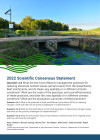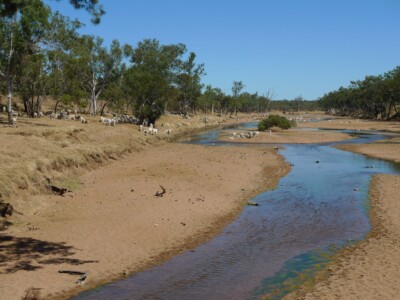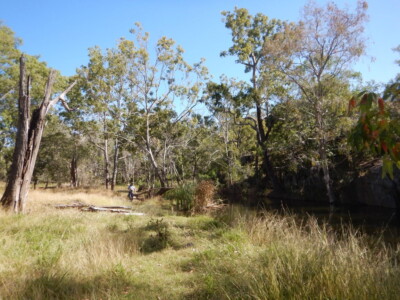Dissolved nutrients

What are the most effective management practices for reducing dissolved nutrient losses (all land uses) from the Great Barrier Reef catchments, and do these vary spatially or in different climatic conditions? What are the costs of the practices, and cost-effectiveness of these practices, and does this vary spatially or in different climatic conditions? What are the production outcomes of these practices? [Q4.6]
What is the potential of Enhanced-Efficiency-Fertilisers (EEFs) in reducing nitrogen runoff and what are the primary challenges in implementation? [Q4.6.1]
What are the implications of mill mud application in influencing nitrogen losses and what are the primary challenges for implementation? [Q4.6.2]
What are the primary factors that influence nutrient losses from irrigated areas and how can these be managed? [Q4.6.3]
Authors: Peter Thorburn1, Kirsten Verburg1, Marina Farr2, Tony Weber3, Maria Vilas4, Caleb Connolly2, Rohan Eccles3
Affiliations: 1CSIRO Agriculture and Food, 2Department of Agriculture and Fisheries, 3Alluvium, 4Department of Environment, Science and Innovation

Evidence Statement
The synthesis of the evidence for Question 4.6 was based on 294 studies, undertaken across the Great Barrier Reef catchment area and wider Australia for non-agricultural/urban-related evidence and published between 1990 and 2022 (plus a few older references dating back to 1976 for non-agricultural/urban evidence). The synthesis includes a High diversity of study types (46% experimental, 21% modelling or conceptual, 15% reviews and secondary analysis, 13% observational and 5% other including mixed studies, social and behavioural), and has a Moderate confidence rating (based on Moderate consistency and Moderate overall relevance of studies).
Summary of findings relevant to policy or management action
Reduced application of nitrogen fertiliser is a consistent means of reducing dissolved inorganic nitrogen exported from fields via all pathways (runoff, leaching and gaseous losses) in different agricultural land uses, climates and management contexts in the Great Barrier Reef catchment area. In sugarcane, nitrogen application rates above industry best practice can result in avoidable nitrogen loss, increase the cost of production and reduce economic returns. However, reducing fertiliser nitrogen rates “too much” can impact on productivity and hence on profitability at the farm and sugarcane mill, although the definition of “too much” is variable. Enhanced-efficiency fertilisers may reduce both dissolved inorganic nitrogen export via leaching and mitigate risks of productivity losses when nitrogen fertiliser applications are reduced. However, the results are highly variable across sites and years and consistent benefits are often only seen when averaged across sites and seasons. There are limited studies that assess the effectiveness, productivity or cost-effectiveness of other sugarcane management practices including mill mud application, subsurface application of fertiliser, improved irrigation, crop residue management and various attributes of improved farming systems (e.g., tillage, fallow legumes) in reducing dissolved inorganic nitrogen export. There is little peer reviewed evidence on the effectiveness of management practices for reducing dissolved inorganic nitrogen export in crops other than sugarcane, or on the management of dissolved phosphorus exports. For urban/non-agricultural land uses, structural measures that include vegetation or biological components, such as wetlands, biofilters, algal ponds and existing riparian zones have considerable potential for removal of diffuse runoff nutrients and may also be important for management of wastewater. Non-structural controls for nutrient management in non-agricultural land uses including policy, planning, regulation, compliance and education, appear to work best when completed as part of an integrated approach. Recycling and reuse of wastewater shows considerable potential, provided that there is careful consideration of the location of water reuse.
Supporting points
- The possible impacts of reducing nitrogen fertiliser rates on productivity and profitability in sugarcane are variable and can be affected by climate, soil and seasonal conditions. As a result, the optimum nitrogen fertiliser rate (i.e., the rate giving near maximum profitability) is both unknown and unpredictable for a specific sugarcane crop. Reducing fertiliser rates reduces the cost of production for crops; however, there may be additional costs such as expenditure on capital or an increase in other business expenses in doing that and there is a risk that productivity will be reduced.
- Reducing nitrogen rate (or applying enhanced-efficiency fertilisers) is likely to provide greater water quality benefits for crops starting later in the year, as the magnitude of dissolved inorganic nitrogen losses will generally be greater closer to the start of the wet season and first rainfall events. This timing may also affect the productivity impact of reduced nitrogen applications.
- Enhanced-efficiency fertilisers act by reducing the concentration of the mobile form of inorganic nitrogen (nitrate) in soils which helps to reduce leaching. Benefits of using enhanced-efficiency fertilisers are likely to be greatest for crops starting in mid- to late-season, in wetter regions and wetter growing seasons. Increased productivity will only occur if dissolved nitrogen leaching is reduced and crop growth at that time is responsive to the additional nitrogen available in the soil. These conditions are more likely on permeable soils. There is limited evidence quantifying the benefits of enhanced-efficiency fertilisers in reducing dissolved inorganic nitrogen losses.
- There is some evidence that applying mill mud to sugarcane can increase losses of dissolved phosphorus, but not nitrogen. Reducing fertiliser application rates in crops following mill mud application seems prudent to reduce risk of additional dissolved phosphorus and nitrogen losses; however, the benefits of these interactions have not been quantified. In addition, the extent to which fertiliser applications can be reduced following mill mud without impacting on crop productivity is unclear.
- The effect of improved irrigation practices on dissolved nutrient losses or on farm productivity in the Great Barrier Reef catchment area is uncertain, with most information derived from mechanistic modelling studies in sugarcane. The available results indicate that high irrigation efficiency resulting from lower irrigation application rates are predicted to reduce dissolved inorganic nitrogen losses from sugarcane crops, but there is a risk that productivity is also reduced. While there is evidence that well-designed and managed automated furrow irrigation systems on sugarcane farms can be profitable, the water quality outcomes of these systems are not clear. Limited evidence suggests that converting to a fully automated irrigation system on banana farms may potentially provide economic benefits.
- There is limited evidence on the effectiveness of management practices for reducing dissolved inorganic nitrogen export in bananas, horticulture and grains. Mechanistic cropping systems models, that have been useful in providing insights in sugarcane production, are not well developed or tested for these crops.
- Factors that influence the cost-effectiveness and productivity of nutrient management practices in cropping include farm size and layout, rainfall patterns, soil type, landholder experience and distance to a processing plant or market. Program and administration costs, transaction costs and the time taken to adopt practices and for benefits to accrue are also important. Better recognition of these factors and more consistent monitoring and reporting will improve understanding of the cost-effectiveness of achieving improved water quality.
- In non-agricultural areas, planning and regulatory requirements are driving innovation in nutrient treatment. The use of planning and regulatory approaches continues to support the application of suitable nutrient management actions (both structural and non-structural) and are most effective when considered in conjunction with specific treatment controls. Biofilters appear to be the most cost-effective treatment systems in this case, but this is based on limited data and modelling studies. Improvements in technologies for wastewater management also show that systems such as membrane filtration and chemical addition are likely to perform well.













